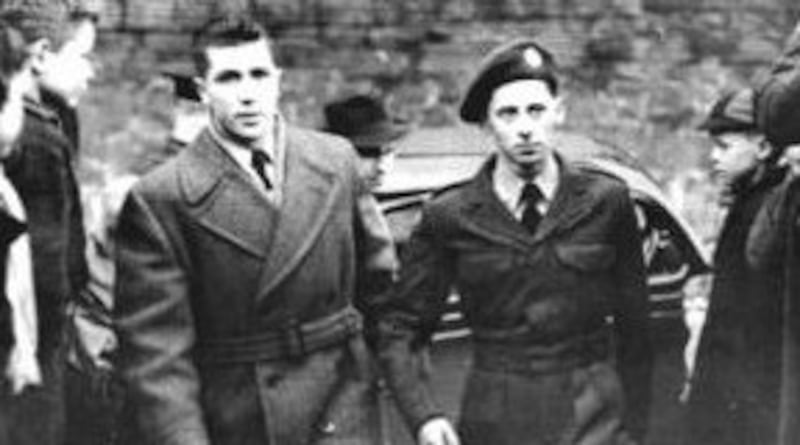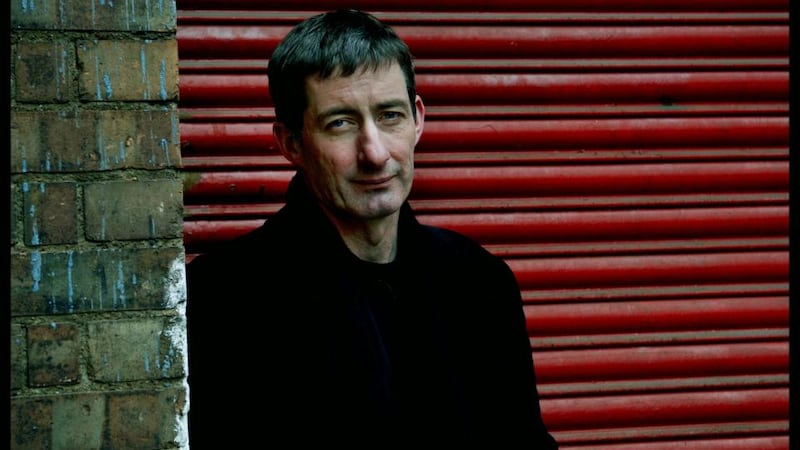After Patricia Curran was murdered, the same photograph was used over and over again in the newspaper coverage of her death. In it, a dark-haired young woman wearing a cowl-knit dress and a string of pearls gazes out at the reader.
“It is the eyes that hold you,” writes Eoin McNamee in his novel about her murder, The Blue Tango. “Her face is dominated by the shadow of them. You are drawn to their mesmeric void.”
Seventy years ago this weekend, the body of the 19-year-old was discovered in the driveway of her family home in Whiteabbey, Co Antrim. The postmortem would conclude she had been stabbed 37 times.
From the very beginning, things did not add up – not least because her brother Desmond and father, Mr Justice Lance Curran, moved her body and the judge used his influence to block police from either searching the house, or interrogating members of his family.
‘A haon, a dó, a trois’: How a tiny French village fell in love with Irish dancing
Last of the Irish Lords: ‘There’s a love-hate relationship between Irish people and Anglo titles’
The White Lotus effect: Who’d associate themselves with such sickening decadence? Almost anyone who can afford to, it seems
Seán Moncrieff: Is Gen Z the most cynically manipulated generation in history?

A young Scottish RAF technician, Iain Hay Gordon, stationed nearby, confessed to her murder after days of questioning, during which he was threatened that his mother would be told he was gay. He was found “guilty but insane” – which meant he avoided the hangman’s noose – and spent seven years in a mental hospital in Antrim until he was abruptly released and told to go back to Glasgow and change his name. His conviction was overturned in 2000. He died in 2012.
Curran’s murder – and the miscarriage of justice which followed – has fascinated people ever since. It has been the subject of television documentaries, podcasts and books, and remains one of the few “true crime” mysteries in Northern Ireland that does not involve the Troubles.

She is “the classic noir heroine – the judge’s daughter,” says McNamee. He recalls how, as a child growing up in Kilkeel, Co Down, there was a drawer in the hot press “lined with newspaper, an old Belfast Telegraph, and the headline was ‘judge’s daughter slain’, with that photograph of Patricia Curran – the one I write about.”
The suspicion is that the murderer was in fact her mother, Lady Doris Curran, who was committed to a mental institution shortly after her daughter’s death
As a writer, he had been thinking about the case for years but he “couldn’t find a way into it”; her photograph, and the discovery that Gordon had whistled a tune, The Blue Tango – which was in the charts at the time – in between interrogations gave him “not just the title of the book, it’s the texture of it, it’s the noir feel of it.
“That kind of started me off on the idea of noir and the idea of predestination which kind of works its way through the book, and the idea of Calvinism where your fate is written before you start out.”
Though “the noir hero is normally a male hero who shakes their fist against fate anyway, tries to change what is already written ... you could write Blue Tango in California, you could make it a Black Dahlia story.
“The roots of that noir was in places like the North and in Scotland, that sort of flinty Calvinism that created that sort of almost baroque – I’m mixing my genres here – baroqueness of noir.”
In recent years, Northern Ireland has built a reputation for its crime fiction. In 2017, Belfast played host to Noireland, the island’s first international crime fiction festival; it was in a strange way a mark of how far the North has come, that the “ordinary crime” of peacetime had replaced that of the Troubles.
[ Locked up for murder: an infamous case and a wrongful convictionOpens in new window ]
The Northern Ireland of 1952 – and Curran’s murder – fits this mould. “Apart from all the other aspects which make people so fascinated about it, it’s that there weren’t any other murders. Murder was very rare in the North,” says McNamee.
He went on to write two more books about murder cases overseen by Judge Curran – Orchid Blue and Blue is the Night – which deal with, respectively, the judge’s sentencing of Robert McGladdery – the last man to be hanged in Northern Ireland – for the murder of 19-year-old Pearl Gamble in 1961 and the Robert the Painter case, about a Protestant, Robert Taylor, on trial for the murder of a Catholic woman, Mary McGowan, in Belfast in 1949, who the judge ensures walks free.
“These were huge cases” because such events appeared so rare then, says McNamee. Yet in 1922 there had been widespread sectarian killings in Belfast: “Where did all that blood go to, where did all that lust and savagery go to over the next 50 years?
“I think it was always there, and maybe these few murders we had were the conduit of that to the surface.”
The connection in all three books – as with other of McNamee’s novels, including those set during the Troubles – is the miscarriage of justice.
Among the “fascinating” aspects of the Curran case, he says, is “this miasma of wrongdoing and transgression, she’d been going out with older men, all this sort of stuff common to sexual crime cases, it had the ‘she brought it on herself’ sort of feeling to it.
“My thinking started out as, who murdered Patricia Curran, and it ended up being, who was Patricia Curran?”
To this day, her murder remains officially unsolved. The suspicion is that the murderer was in fact her mother, Lady Doris Curran, who was committed to a mental institution shortly after her daughter’s death.
Former Irish Times journalist Kieran Fagan, who has published a book, Who Killed Patricia Curran?, detailing his investigation into her murder, is “certain” she was responsible. He too first came across the case as a child; almost eight years-old when the trial started in 1953 and off sick from school, he “started reading the very lengthy accounts in the Irish Press of the case, and it has stuck with me ever since”.

Even in his home in Dublin, “it was huge; my parents spoke about it, their friends spoke about it. The Irish Press wasn’t particularly interested in Northern Ireland ... but it still devoted acres of space to it”.
During his research, he interviewed many people in the North, including some who remembered the murdered teenager and others who met Gordon after he was sent to the asylum in Antrim town.
“I spoke to people who knew him and trusted him and knew he wasn’t ... there wasn’t that badness in him, that he would stab anybody 37 times.
“Just think of the act of that, and there wasn’t a speck of blood or any other evidence attached to him; that man couldn’t have organised that, he just couldn’t have done.
“The question of how an appeal could be delayed by almost 50 years is something people should be concerned about.”
This is one of the multiple tragedies of this case, he says, for the Currans, for Gordon and his family, and “the tragedy of a legal system that knew at the time of the trial, in 1953 eminent lawyers knew this was a bad verdict and it took nearly 50 years to remedy”.
Patricia Curran was a daughter, sister and friend; a spirited young woman who was studying arts at Queen’s University Belfast and took a summer job as a lorry driver and who, says McNamee, “could be seen as a proto-feminist, she was certainly someone who went against the very paternalistic grain of the North in the 1950s”.
For Fagan, she was a “practical young woman”, someone who “just didn’t fit into the conception of the ideal unionist wife. Today, she would be studying engineering or science at university. She’d be a civil engineer”.
McNamee comes back to a conversation he had with a friend who had met Curran while she was delivering building supplies in the lorry: “He said she was just a nice wee girl.”















